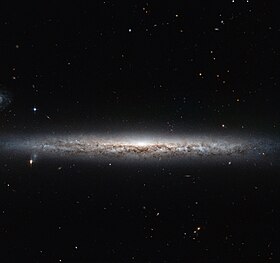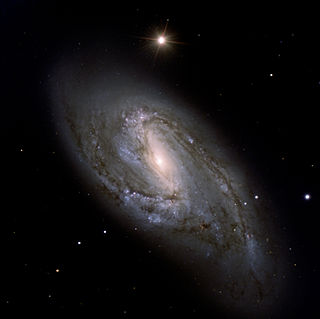
Messier 66 or M66, also known as NGC 3627, is an intermediate spiral galaxy in the southern, equatorial half of Leo. It was discovered by French astronomer Charles Messier on 1 March 1780, who described it as "very long and very faint". This galaxy is a member of a small group of galaxies that includes M65 and NGC 3628, known as the Leo Triplet or the M66 Group. M65 and M66 are a common object for amateur astronomic observation, being separated by only 20′.
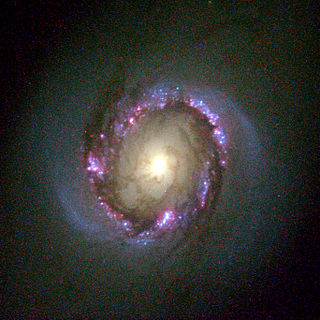
NGC 4314 is a barred spiral galaxy approximately 53 million light-years away in the northern constellation of Coma Berenices. It is positioned around 3° to the north and slightly west of the star Gamma Comae Berenices and is visible in a small telescope. The galaxy was discovered by German-born astronomer William Herschel on March 13, 1785. It was labelled as peculiar by Allan Sandage in 1961 because of the unusual structure in the center of the bar. NGC 4314 is a member of the Coma I group of galaxies.

NGC 4319 is a face-on barred spiral galaxy located about 77 million light years away in the constellation Draco. The morphological classification is SB(r)ab, which indicates it is a barred spiral with an inner ring structure and moderate to tightly wound arms. It is situated in physical proximity to the galaxies NGC 4291 and NGC 4386, with X-ray emissions from the intervening gap indicating NGC 4319 and NGC 4291 may be interacting. NGC 4319 has a much higher proportion of ionized hydrogen compared to the Milky Way galaxy.

NGC 7673 is a disturbed spiral galaxy located in the constellation Pegasus. The galaxy has recently experienced intense star formation activity and may therefore be referred to as a starburst galaxy.

NGC 925 is a barred spiral galaxy located about 30 million light-years away in the constellation Triangulum. The morphological classification of this galaxy is SB(s)d, indicating that it has a bar structure and loosely wound spiral arms with no ring. The spiral arm to the south is stronger than the northern arm, with the latter appearing flocculent and less coherent. The bar is offset from the center of the galaxy and is the site of star formation all along its length. Both of these morphological traits—a dominant spiral arm and the offset bar—are typically characteristics of a Magellanic spiral galaxy. The galaxy is inclined at an angle of 55° to the line of sight along a position angle of 102°.

The 2MASX J00482185−2507365 occulting pair is a pair of overlapping spiral galaxies found in the vicinity of NGC 253, the Sculptor Galaxy. Both galaxies are more distant than NGC 253, with the background galaxy, 2MASX J00482185−2507365, lying at redshift z=0.06, about 800 million light-years from Earth, and the foreground galaxy lying between NGC 253 and the background galaxy.

NGC 2775, also known as Caldwell 48, is a spiral galaxy in the constellation Cancer. It is 67 million light-years away from the Milky Way. It was discovered by William Herschel in 1783. NGC 2775 belongs to the Antlia-Hydra Cluster of galaxies and is the most prominent member of the NGC 2775 Group, a small galaxy group in the Virgo Supercluster, along with the Local Group. Other members of the NGC 2775 Group include NGC 2777 and UGC 4781.

NGC 5775 is a spiral galaxy, a member of the Virgo Cluster, that lies at a distance of about 70 million light-years. Although the spiral is tilted away from us, with only a thin sliver in view, such a perspective can be advantageous for astronomers. For instance, astronomers have previously used the high inclination of this spiral to study the properties of the halo of hot gas that is visible when the galaxy is observed at X-ray wavelengths. It is a member of the NGC 5775 Group of galaxies, itself one of the Virgo III Groups strung out to the east of the Virgo Supercluster of galaxies.
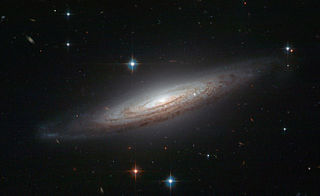
NGC 634 is a spiral galaxy, lying at a distance of 217.1 megalight-years away from the Milky Way in the northern constellation of Triangulum. This object was discovered in the nineteenth century by French astronomer Édouard Stephan. It is inclined by an angle of 82.4° to the line of sight from the Earth, and thus is being viewed nearly edge on.

NGC 3259 is a barred spiral galaxy located approximately 90 million light-years from Earth, in the Ursa Major constellation. It has the morphological classification SAB(rs)bc, which indicates that it is a spiral galaxy with a weak bar across the nucleus (SAB), an incomplete inner ring structure circling the bar (rs), and moderate to loosely wound spiral arms (bc). This galaxy is a known source of X-ray emission and it has an active galactic nucleus of the Seyfert 2 type.

NGC 4634 is an edge-on barred spiral galaxy located about 70 million light-years away in the constellation of Coma Berenices. NGC 4634 was discovered by astronomer William Herschel on January 14, 1787. It is interacting with the spiral galaxy NGC 4633. Both galaxies are members of the Virgo Cluster.

NGC 613 is a barred spiral galaxy located 67 million light years away in the southern constellation of Sculptor. This galaxy was discovered in 1798 by German-English astronomer William Herschel, then re-discovered and catalogued by Scottish astronomer James Dunlop. It was first photographed in 1912, which revealed the spiral form of the nebula. During the twentieth century, radio telescope observations showed that a linear feature in the nucleus was a relatively strong source of radio emission.

NGC 4030 is a grand design spiral galaxy located about 64 million light years away in the constellation Virgo. It is a member of the NGC 4030 Group of galaxies, which is a member of the Virgo II Groups, a series of galaxies and galaxy clusters strung out from the southern edge of the Virgo Supercluster. With an apparent visual magnitude of 10.6, it is visible with a small telescope as a 3 arc minute wide feature about 4.75° to the southeast of the star Beta Virginis. It is inclined by an angle of 47.1° to the line of sight from the Earth and is receding at a velocity of 1,465 km/s.
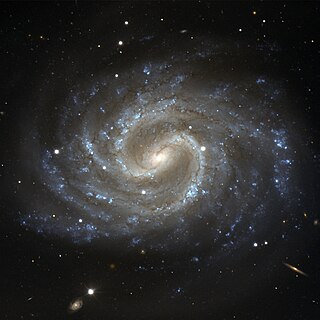
NGC 4535 is a barred spiral galaxy located some 54 million light years from Earth in the constellation Virgo. It is a member of the Virgo Cluster of galaxies and is located 4.3° from Messier 87. The galactic plane of NGC 4535 is inclined by an angle of 43° to the line of sight from the Earth. The morphological classification of NGC 4535 in the De Vaucouleurs system is SAB(s)c, which indicates a bar structure across the core (SAB), no ring (s), and loosely wound spiral arms (c). The inner part of the galaxy has two spiral arms, which branch into multiple arms further away. The small nucleus is of type HII, meaning the spectrum resembles that of an H II region.

NGC 4217 is an edge-on spiral galaxy which lies approximately 60 million light-years away in the constellation of Canes Venatici. It is a possible companion galaxy to Messier 106.

NGC 5985 is a spiral galaxy located in the northern constellation Draco. NGC 5985 was discovered by William Herschel in 1788.

NGC 1084 is an unbarred spiral galaxy in the constellation Eridanus. It is located at a distance of about 63 million light-years away from the Milky Way. The galaxy was discovered by William Herschel on 10 January 1785. It has multiple spiral arms, which are not well defined. It belongs in the same galaxy group with NGC 988, NGC 991, NGC 1022, NGC 1035, NGC 1042, NGC 1047, NGC 1052 and NGC 1110. This group is in turn associated with the Messier 77 group.

NGC 6052 is a pair of galaxies in the constellation of Hercules. It was discovered on 11 June 1784 by William Herschel. It was described as "faint, pretty large, irregularly round" by John Louis Emil Dreyer, the compiler of the New General Catalogue.

NGC 3274 is a relatively faint spiral galaxy discovered by Wilhelm Herschel in 1783, and is located over 20 million light-years away in the constellation of Leo.

NGC 3610 is an elliptical galaxy in the constellation Ursa Major. It was discovered on 8 April 1793 by William Herschel.
